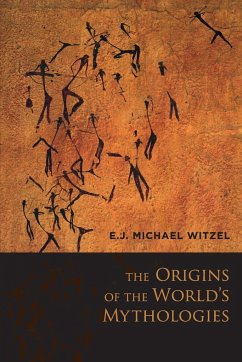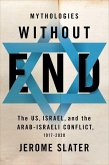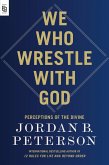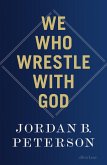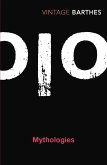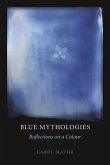E.J. Michael Witzel (Wales Professor o Wales Professor of Sanskrit
The Origins of the World's Mythologies
E.J. Michael Witzel (Wales Professor o Wales Professor of Sanskrit
The Origins of the World's Mythologies
- Broschiertes Buch
- Merkliste
- Auf die Merkliste
- Bewerten Bewerten
- Teilen
- Produkt teilen
- Produkterinnerung
- Produkterinnerung
Michael Witzel persuasively demonstrates the prehistoric origins of most of the mythologies of Eurasia and the Americas ('Laurasia').
Andere Kunden interessierten sich auch für
![Mythologies Without End Mythologies Without End]() Jerome Slater (Professor E Professor Emeritus of Political ScienceMythologies Without End37,99 €
Jerome Slater (Professor E Professor Emeritus of Political ScienceMythologies Without End37,99 €![We Who Wrestle with God We Who Wrestle with God]() Jordan B. PetersonWe Who Wrestle with God19,38 €
Jordan B. PetersonWe Who Wrestle with God19,38 €![We Who Wrestle With God We Who Wrestle With God]() Jordan B. PetersonWe Who Wrestle With God41,99 €
Jordan B. PetersonWe Who Wrestle With God41,99 €![Mythology. 75th Anniversary Illustrated Edition Mythology. 75th Anniversary Illustrated Edition]() Edith HamiltonMythology. 75th Anniversary Illustrated Edition10,99 €
Edith HamiltonMythology. 75th Anniversary Illustrated Edition10,99 €![Mythologies Mythologies]() Roland BarthesMythologies13,99 €
Roland BarthesMythologies13,99 €![Before and After Gender - Sexual Mythologies of Everyday Life Before and After Gender - Sexual Mythologies of Everyday Life]() Marilyn StrathernBefore and After Gender - Sexual Mythologies of Everyday Life37,99 €
Marilyn StrathernBefore and After Gender - Sexual Mythologies of Everyday Life37,99 €![Blue Mythologies Blue Mythologies]() Carol MavorBlue Mythologies22,99 €
Carol MavorBlue Mythologies22,99 €-
-
-
Michael Witzel persuasively demonstrates the prehistoric origins of most of the mythologies of Eurasia and the Americas ('Laurasia').
Hinweis: Dieser Artikel kann nur an eine deutsche Lieferadresse ausgeliefert werden.
Hinweis: Dieser Artikel kann nur an eine deutsche Lieferadresse ausgeliefert werden.
Produktdetails
- Produktdetails
- Verlag: Oxford University Press Inc
- Seitenzahl: 688
- Erscheinungstermin: 1. Januar 2013
- Englisch
- Abmessung: 234mm x 156mm x 41mm
- Gewicht: 1054g
- ISBN-13: 9780199812851
- ISBN-10: 0199812853
- Artikelnr.: 37780072
- Herstellerkennzeichnung
- Books on Demand GmbH
- In de Tarpen 42
- 22848 Norderstedt
- info@bod.de
- 040 53433511
- Verlag: Oxford University Press Inc
- Seitenzahl: 688
- Erscheinungstermin: 1. Januar 2013
- Englisch
- Abmessung: 234mm x 156mm x 41mm
- Gewicht: 1054g
- ISBN-13: 9780199812851
- ISBN-10: 0199812853
- Artikelnr.: 37780072
- Herstellerkennzeichnung
- Books on Demand GmbH
- In de Tarpen 42
- 22848 Norderstedt
- info@bod.de
- 040 53433511
Wales Professor of Sanskrit, Harvard University
* Contents
* §1 Introduction
* 1.1 What is myth, how do we study and compare it?
* 1.2 Definition; study of myth in the past
* 1.3 Comparative mythology
* 1.4 Laurasian mythology: establishing the common origin of the
mythologies of Eurasia and the Americas
* 1.5 Earlier explanations of myth
* 1.6 Ur-forms, history, and archaeology
* 1.7 Summary
* § 2 Comparison and Theory
* 2.1 Theory and practice of comparisons
* 2.2 Reconstructing Laurasian mythology
* 2.2.1 Similarities
* 2.2.2 Regular correspondences and establishment of a unified
narrative scheme
* 2.2.3 Oldest texts to be used
* 2.2.4 Geographically dispersed items
* 2.2.5 Reconstruction of the Laurasian common story line and
individual myths
* 2.3 Enhancing the reconstruction: local, regional, macro-regional,
and subcontinental variations
* 2.4 Reconstructing the Laurasian mythological system and inherent
problems
* 2.5 Structure and content in some macro-areas of Laurasian myth.
* 2.5.1 Macro-areas
* 2.5.2 The Four ages in the Eurasian and Meso-American macro-areas
* 2.5.3 Later centers of innovations
* 2.5.4 Late borrowings (diffusion)
* 2.6 Some objections to the approach of historical comparative
mythology
* 2.7 Conclusion
* § 3 Creation Myths: The Laurasian Story Line, Our First Novel
* 3.1 Primordial Creation
* 1. Chaos and darkness 2. Water 3. Earth diver and floating earth 4.
Giant 5. Bull 6. Egg 7. Combined versions
* 3.2 Father Heaven, Mother Earth
* 3.3 Separation of heaven and earth, the prop
* 3.4. Creation of land
* 3.5 The demiurge or trickster
* 3.5.1 Creation of light
* 3.5.2. The slaying of the dragon
* 3.5.3 The theft of fire and of the heavenly drink
* 3.6 Generations, Four Ages and five suns
* 3.7 The creation of humans
* 3.8 Descent of 'noble' lineages
* 3.9 The flood
* 3.10 Heroes
* 3.11 The final destruction
* 3.12 Summary
* § 4 The Contributions of Other Sciences: comparison of language,
physical anthropology, genetics, archaeology
* 4.1. Linguistics
* 4.2 Physical anthropology
* 4.3. Genetics
* 4.3.1 Recent advances in human population genetics
* 4.3.2 Overview of recent developments
* 4.3.3 Out of Africa
* 4.3.4 Movement northward after the last two Ice Ages
* 4.3.5 Genetics, language and mythology
* 4.3.6 Summary and outlook
* 4.4. Archaeology
* 4.4.1 Cave paintings and plastic art
* 4.4.2 Sacrifice in Late Palaeolithic art
* 4.4.3 Food production
* 4.4.4 Domestic animals and pastoralism
* 4.5 Other items of comparison: children's songs and games; ancient
music and regional styles; use of colors; gestures and their regional
variations.
* 4.6. Conclusions resulting from the comparison of the sciences
involved
* § 5 The Countercheck: Australia, Melanesia, sub-Saharan Africa
* 5.1 Possible ways to countercheck
* 5.1.1 Method
* 5.1.2 Criteria for testing the theory
* 5.1.3 Diffusion vs genetic relationship
* 5.1.4 Later additions
* 5.2 Beyond Laurasia: Gondwana mythology
* 5.3. Gondwana mythologies
* 5.3.1 Sub-Saharan Africa, the Andamans, New Guinea, Australia and
Tasmania -- an overview
* 5.3.2 Australia
* 5.3.2.1 Tasmania
* 5.3.3. Melanesia
* 5.3.3.1 Negritos and other southern remnant populations
* 5.3.4 Andaman Islands
* 5.3.5 Africa
* 5.3.5.1 Remnant populations: San and Pygmies
* 5.3.5.2 Sub-Saharan Africa
* 5.3.5.3 Northern influences: the western North-South highway
* 5.3.5.4 The eastern North-South Highway
* 5.3.6 Summary
* 5.4. Individual Gondwana myth types and their common characteristics
* 5.5 Secondary influences on Gondwana mythology
* 5.6. Conflicting myths in Gondwanaland
* 5.6.1 Gondwana element in Laurasian myth
* 5.6.2 Laurasian elements in Gondwana myth
* 5.7 Countercheck of Laurasian mythology based on Gondwana mythology
* 5.7.1 Essential features of Gondwana and Laurasian mythology
* 5.7.2 The flood myth in world wide perspective
* § 6 First Tales: Pan-Gaean Mythology
* 6.1 Beyond Laurasia and Gondwana: common myths
* 6.2 Our first tales
* § 7 Laurasian Mythology in Historical Development
* 7.1 Late Palaeolithic religion
* 7.1.1 Late Palaeolithic shamanism
* 7.1.2 Sacrifice
* 7.2. Changes from Palaeolithic to state societies
* 7.3. Dating Gondwana and Laurasian mythology
* § 8 Outlook
* 8.1 The meaning of Laurasian Mythology
* 8.2 Beyond Laurasia, Gondwana and Pan-Gaia
* 8.2.1 Persistence of myth
* 8.2.2 Some reasons
* 8.3 Epilogue
* §1 Introduction
* 1.1 What is myth, how do we study and compare it?
* 1.2 Definition; study of myth in the past
* 1.3 Comparative mythology
* 1.4 Laurasian mythology: establishing the common origin of the
mythologies of Eurasia and the Americas
* 1.5 Earlier explanations of myth
* 1.6 Ur-forms, history, and archaeology
* 1.7 Summary
* § 2 Comparison and Theory
* 2.1 Theory and practice of comparisons
* 2.2 Reconstructing Laurasian mythology
* 2.2.1 Similarities
* 2.2.2 Regular correspondences and establishment of a unified
narrative scheme
* 2.2.3 Oldest texts to be used
* 2.2.4 Geographically dispersed items
* 2.2.5 Reconstruction of the Laurasian common story line and
individual myths
* 2.3 Enhancing the reconstruction: local, regional, macro-regional,
and subcontinental variations
* 2.4 Reconstructing the Laurasian mythological system and inherent
problems
* 2.5 Structure and content in some macro-areas of Laurasian myth.
* 2.5.1 Macro-areas
* 2.5.2 The Four ages in the Eurasian and Meso-American macro-areas
* 2.5.3 Later centers of innovations
* 2.5.4 Late borrowings (diffusion)
* 2.6 Some objections to the approach of historical comparative
mythology
* 2.7 Conclusion
* § 3 Creation Myths: The Laurasian Story Line, Our First Novel
* 3.1 Primordial Creation
* 1. Chaos and darkness 2. Water 3. Earth diver and floating earth 4.
Giant 5. Bull 6. Egg 7. Combined versions
* 3.2 Father Heaven, Mother Earth
* 3.3 Separation of heaven and earth, the prop
* 3.4. Creation of land
* 3.5 The demiurge or trickster
* 3.5.1 Creation of light
* 3.5.2. The slaying of the dragon
* 3.5.3 The theft of fire and of the heavenly drink
* 3.6 Generations, Four Ages and five suns
* 3.7 The creation of humans
* 3.8 Descent of 'noble' lineages
* 3.9 The flood
* 3.10 Heroes
* 3.11 The final destruction
* 3.12 Summary
* § 4 The Contributions of Other Sciences: comparison of language,
physical anthropology, genetics, archaeology
* 4.1. Linguistics
* 4.2 Physical anthropology
* 4.3. Genetics
* 4.3.1 Recent advances in human population genetics
* 4.3.2 Overview of recent developments
* 4.3.3 Out of Africa
* 4.3.4 Movement northward after the last two Ice Ages
* 4.3.5 Genetics, language and mythology
* 4.3.6 Summary and outlook
* 4.4. Archaeology
* 4.4.1 Cave paintings and plastic art
* 4.4.2 Sacrifice in Late Palaeolithic art
* 4.4.3 Food production
* 4.4.4 Domestic animals and pastoralism
* 4.5 Other items of comparison: children's songs and games; ancient
music and regional styles; use of colors; gestures and their regional
variations.
* 4.6. Conclusions resulting from the comparison of the sciences
involved
* § 5 The Countercheck: Australia, Melanesia, sub-Saharan Africa
* 5.1 Possible ways to countercheck
* 5.1.1 Method
* 5.1.2 Criteria for testing the theory
* 5.1.3 Diffusion vs genetic relationship
* 5.1.4 Later additions
* 5.2 Beyond Laurasia: Gondwana mythology
* 5.3. Gondwana mythologies
* 5.3.1 Sub-Saharan Africa, the Andamans, New Guinea, Australia and
Tasmania -- an overview
* 5.3.2 Australia
* 5.3.2.1 Tasmania
* 5.3.3. Melanesia
* 5.3.3.1 Negritos and other southern remnant populations
* 5.3.4 Andaman Islands
* 5.3.5 Africa
* 5.3.5.1 Remnant populations: San and Pygmies
* 5.3.5.2 Sub-Saharan Africa
* 5.3.5.3 Northern influences: the western North-South highway
* 5.3.5.4 The eastern North-South Highway
* 5.3.6 Summary
* 5.4. Individual Gondwana myth types and their common characteristics
* 5.5 Secondary influences on Gondwana mythology
* 5.6. Conflicting myths in Gondwanaland
* 5.6.1 Gondwana element in Laurasian myth
* 5.6.2 Laurasian elements in Gondwana myth
* 5.7 Countercheck of Laurasian mythology based on Gondwana mythology
* 5.7.1 Essential features of Gondwana and Laurasian mythology
* 5.7.2 The flood myth in world wide perspective
* § 6 First Tales: Pan-Gaean Mythology
* 6.1 Beyond Laurasia and Gondwana: common myths
* 6.2 Our first tales
* § 7 Laurasian Mythology in Historical Development
* 7.1 Late Palaeolithic religion
* 7.1.1 Late Palaeolithic shamanism
* 7.1.2 Sacrifice
* 7.2. Changes from Palaeolithic to state societies
* 7.3. Dating Gondwana and Laurasian mythology
* § 8 Outlook
* 8.1 The meaning of Laurasian Mythology
* 8.2 Beyond Laurasia, Gondwana and Pan-Gaia
* 8.2.1 Persistence of myth
* 8.2.2 Some reasons
* 8.3 Epilogue
* Contents
* §1 Introduction
* 1.1 What is myth, how do we study and compare it?
* 1.2 Definition; study of myth in the past
* 1.3 Comparative mythology
* 1.4 Laurasian mythology: establishing the common origin of the
mythologies of Eurasia and the Americas
* 1.5 Earlier explanations of myth
* 1.6 Ur-forms, history, and archaeology
* 1.7 Summary
* § 2 Comparison and Theory
* 2.1 Theory and practice of comparisons
* 2.2 Reconstructing Laurasian mythology
* 2.2.1 Similarities
* 2.2.2 Regular correspondences and establishment of a unified
narrative scheme
* 2.2.3 Oldest texts to be used
* 2.2.4 Geographically dispersed items
* 2.2.5 Reconstruction of the Laurasian common story line and
individual myths
* 2.3 Enhancing the reconstruction: local, regional, macro-regional,
and subcontinental variations
* 2.4 Reconstructing the Laurasian mythological system and inherent
problems
* 2.5 Structure and content in some macro-areas of Laurasian myth.
* 2.5.1 Macro-areas
* 2.5.2 The Four ages in the Eurasian and Meso-American macro-areas
* 2.5.3 Later centers of innovations
* 2.5.4 Late borrowings (diffusion)
* 2.6 Some objections to the approach of historical comparative
mythology
* 2.7 Conclusion
* § 3 Creation Myths: The Laurasian Story Line, Our First Novel
* 3.1 Primordial Creation
* 1. Chaos and darkness 2. Water 3. Earth diver and floating earth 4.
Giant 5. Bull 6. Egg 7. Combined versions
* 3.2 Father Heaven, Mother Earth
* 3.3 Separation of heaven and earth, the prop
* 3.4. Creation of land
* 3.5 The demiurge or trickster
* 3.5.1 Creation of light
* 3.5.2. The slaying of the dragon
* 3.5.3 The theft of fire and of the heavenly drink
* 3.6 Generations, Four Ages and five suns
* 3.7 The creation of humans
* 3.8 Descent of 'noble' lineages
* 3.9 The flood
* 3.10 Heroes
* 3.11 The final destruction
* 3.12 Summary
* § 4 The Contributions of Other Sciences: comparison of language,
physical anthropology, genetics, archaeology
* 4.1. Linguistics
* 4.2 Physical anthropology
* 4.3. Genetics
* 4.3.1 Recent advances in human population genetics
* 4.3.2 Overview of recent developments
* 4.3.3 Out of Africa
* 4.3.4 Movement northward after the last two Ice Ages
* 4.3.5 Genetics, language and mythology
* 4.3.6 Summary and outlook
* 4.4. Archaeology
* 4.4.1 Cave paintings and plastic art
* 4.4.2 Sacrifice in Late Palaeolithic art
* 4.4.3 Food production
* 4.4.4 Domestic animals and pastoralism
* 4.5 Other items of comparison: children's songs and games; ancient
music and regional styles; use of colors; gestures and their regional
variations.
* 4.6. Conclusions resulting from the comparison of the sciences
involved
* § 5 The Countercheck: Australia, Melanesia, sub-Saharan Africa
* 5.1 Possible ways to countercheck
* 5.1.1 Method
* 5.1.2 Criteria for testing the theory
* 5.1.3 Diffusion vs genetic relationship
* 5.1.4 Later additions
* 5.2 Beyond Laurasia: Gondwana mythology
* 5.3. Gondwana mythologies
* 5.3.1 Sub-Saharan Africa, the Andamans, New Guinea, Australia and
Tasmania -- an overview
* 5.3.2 Australia
* 5.3.2.1 Tasmania
* 5.3.3. Melanesia
* 5.3.3.1 Negritos and other southern remnant populations
* 5.3.4 Andaman Islands
* 5.3.5 Africa
* 5.3.5.1 Remnant populations: San and Pygmies
* 5.3.5.2 Sub-Saharan Africa
* 5.3.5.3 Northern influences: the western North-South highway
* 5.3.5.4 The eastern North-South Highway
* 5.3.6 Summary
* 5.4. Individual Gondwana myth types and their common characteristics
* 5.5 Secondary influences on Gondwana mythology
* 5.6. Conflicting myths in Gondwanaland
* 5.6.1 Gondwana element in Laurasian myth
* 5.6.2 Laurasian elements in Gondwana myth
* 5.7 Countercheck of Laurasian mythology based on Gondwana mythology
* 5.7.1 Essential features of Gondwana and Laurasian mythology
* 5.7.2 The flood myth in world wide perspective
* § 6 First Tales: Pan-Gaean Mythology
* 6.1 Beyond Laurasia and Gondwana: common myths
* 6.2 Our first tales
* § 7 Laurasian Mythology in Historical Development
* 7.1 Late Palaeolithic religion
* 7.1.1 Late Palaeolithic shamanism
* 7.1.2 Sacrifice
* 7.2. Changes from Palaeolithic to state societies
* 7.3. Dating Gondwana and Laurasian mythology
* § 8 Outlook
* 8.1 The meaning of Laurasian Mythology
* 8.2 Beyond Laurasia, Gondwana and Pan-Gaia
* 8.2.1 Persistence of myth
* 8.2.2 Some reasons
* 8.3 Epilogue
* §1 Introduction
* 1.1 What is myth, how do we study and compare it?
* 1.2 Definition; study of myth in the past
* 1.3 Comparative mythology
* 1.4 Laurasian mythology: establishing the common origin of the
mythologies of Eurasia and the Americas
* 1.5 Earlier explanations of myth
* 1.6 Ur-forms, history, and archaeology
* 1.7 Summary
* § 2 Comparison and Theory
* 2.1 Theory and practice of comparisons
* 2.2 Reconstructing Laurasian mythology
* 2.2.1 Similarities
* 2.2.2 Regular correspondences and establishment of a unified
narrative scheme
* 2.2.3 Oldest texts to be used
* 2.2.4 Geographically dispersed items
* 2.2.5 Reconstruction of the Laurasian common story line and
individual myths
* 2.3 Enhancing the reconstruction: local, regional, macro-regional,
and subcontinental variations
* 2.4 Reconstructing the Laurasian mythological system and inherent
problems
* 2.5 Structure and content in some macro-areas of Laurasian myth.
* 2.5.1 Macro-areas
* 2.5.2 The Four ages in the Eurasian and Meso-American macro-areas
* 2.5.3 Later centers of innovations
* 2.5.4 Late borrowings (diffusion)
* 2.6 Some objections to the approach of historical comparative
mythology
* 2.7 Conclusion
* § 3 Creation Myths: The Laurasian Story Line, Our First Novel
* 3.1 Primordial Creation
* 1. Chaos and darkness 2. Water 3. Earth diver and floating earth 4.
Giant 5. Bull 6. Egg 7. Combined versions
* 3.2 Father Heaven, Mother Earth
* 3.3 Separation of heaven and earth, the prop
* 3.4. Creation of land
* 3.5 The demiurge or trickster
* 3.5.1 Creation of light
* 3.5.2. The slaying of the dragon
* 3.5.3 The theft of fire and of the heavenly drink
* 3.6 Generations, Four Ages and five suns
* 3.7 The creation of humans
* 3.8 Descent of 'noble' lineages
* 3.9 The flood
* 3.10 Heroes
* 3.11 The final destruction
* 3.12 Summary
* § 4 The Contributions of Other Sciences: comparison of language,
physical anthropology, genetics, archaeology
* 4.1. Linguistics
* 4.2 Physical anthropology
* 4.3. Genetics
* 4.3.1 Recent advances in human population genetics
* 4.3.2 Overview of recent developments
* 4.3.3 Out of Africa
* 4.3.4 Movement northward after the last two Ice Ages
* 4.3.5 Genetics, language and mythology
* 4.3.6 Summary and outlook
* 4.4. Archaeology
* 4.4.1 Cave paintings and plastic art
* 4.4.2 Sacrifice in Late Palaeolithic art
* 4.4.3 Food production
* 4.4.4 Domestic animals and pastoralism
* 4.5 Other items of comparison: children's songs and games; ancient
music and regional styles; use of colors; gestures and their regional
variations.
* 4.6. Conclusions resulting from the comparison of the sciences
involved
* § 5 The Countercheck: Australia, Melanesia, sub-Saharan Africa
* 5.1 Possible ways to countercheck
* 5.1.1 Method
* 5.1.2 Criteria for testing the theory
* 5.1.3 Diffusion vs genetic relationship
* 5.1.4 Later additions
* 5.2 Beyond Laurasia: Gondwana mythology
* 5.3. Gondwana mythologies
* 5.3.1 Sub-Saharan Africa, the Andamans, New Guinea, Australia and
Tasmania -- an overview
* 5.3.2 Australia
* 5.3.2.1 Tasmania
* 5.3.3. Melanesia
* 5.3.3.1 Negritos and other southern remnant populations
* 5.3.4 Andaman Islands
* 5.3.5 Africa
* 5.3.5.1 Remnant populations: San and Pygmies
* 5.3.5.2 Sub-Saharan Africa
* 5.3.5.3 Northern influences: the western North-South highway
* 5.3.5.4 The eastern North-South Highway
* 5.3.6 Summary
* 5.4. Individual Gondwana myth types and their common characteristics
* 5.5 Secondary influences on Gondwana mythology
* 5.6. Conflicting myths in Gondwanaland
* 5.6.1 Gondwana element in Laurasian myth
* 5.6.2 Laurasian elements in Gondwana myth
* 5.7 Countercheck of Laurasian mythology based on Gondwana mythology
* 5.7.1 Essential features of Gondwana and Laurasian mythology
* 5.7.2 The flood myth in world wide perspective
* § 6 First Tales: Pan-Gaean Mythology
* 6.1 Beyond Laurasia and Gondwana: common myths
* 6.2 Our first tales
* § 7 Laurasian Mythology in Historical Development
* 7.1 Late Palaeolithic religion
* 7.1.1 Late Palaeolithic shamanism
* 7.1.2 Sacrifice
* 7.2. Changes from Palaeolithic to state societies
* 7.3. Dating Gondwana and Laurasian mythology
* § 8 Outlook
* 8.1 The meaning of Laurasian Mythology
* 8.2 Beyond Laurasia, Gondwana and Pan-Gaia
* 8.2.1 Persistence of myth
* 8.2.2 Some reasons
* 8.3 Epilogue

